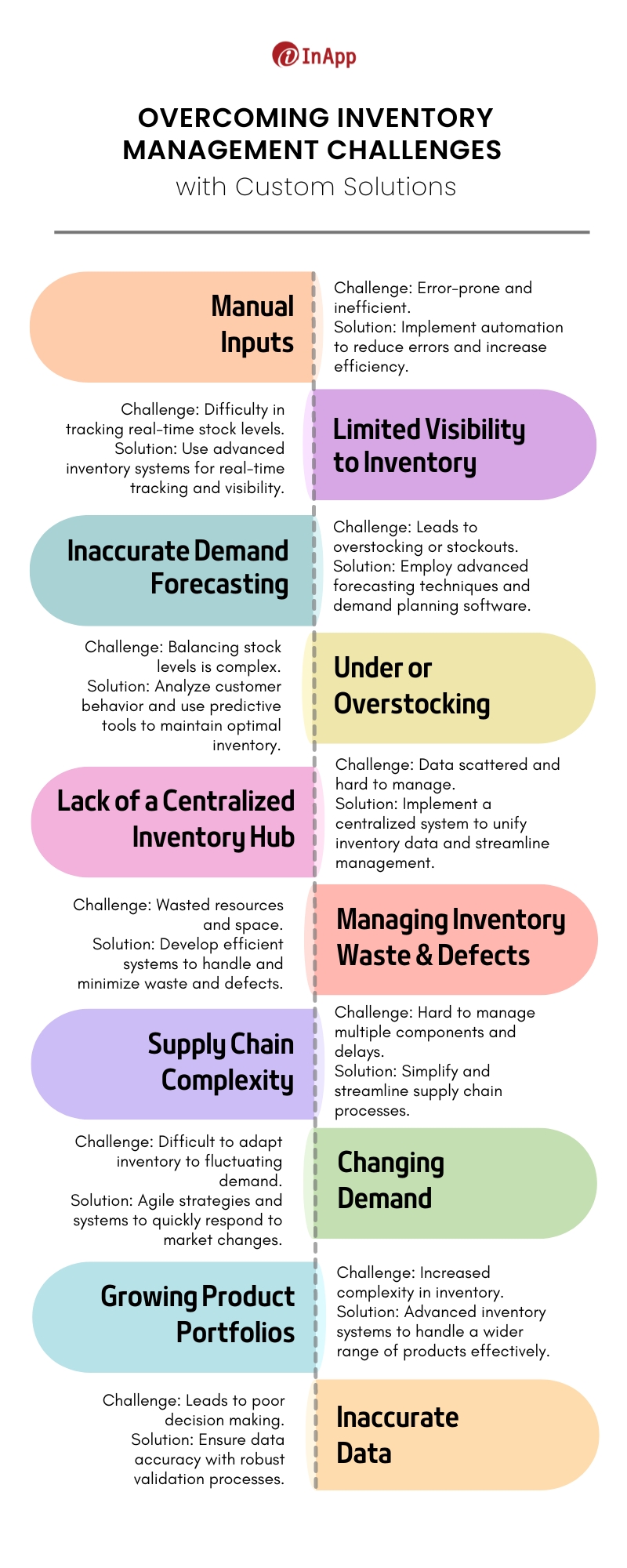Amidst unprecedented disruptions in the global supply chain and unexpected market fluctuations, inventory management has evolved into a formidable challenge. Traditional approaches find themselves outdated and strained in meeting the surging demands imposed by these new circumstances.
In this blog post, we will discuss the ten common challenges with inventory management and, more importantly, explore how custom solutions help organizations overcome these hurdles.
Here are the 10 Common Inventory Management Problems & Solutions
In the manufacturing sector, maintaining an equilibrium between supply and demand is paramount, and proper inventory management is the key to balancing this. The significance of efficient inventory control cannot be overstated, as it plays a pivotal role in navigating the dynamic market demands.
Over the years, inventory management practices have evolved; however, traditional approaches now find themselves inadequate in meeting the growing demands of today’s market. Here, are ten prevailing challenges in inventory management, each posing a hurdle to achieving success.

1. Manual Inputs
Manual inputs pose a serious challenge in inventory management as they introduce the risk of errors and inefficiencies. For instance, a simple typo during data entry might mislabel a product’s quantity or misclassify an item. This seemingly simple mistake can cascade into more significant issues, such as overordering or stockouts.
The solution to this is automation!
Automating the manual processes with technology will reduce the likelihood of human error, ensuring accurate and reliable inventory records for better decision-making and operational efficiency.
2. Limited visibility to Inventory
Limited visibility is another common hurdle in inventory management, making it tricky for businesses to see their stock levels in real time. This lack of clarity can lead to problems like running out of stock or having too much or causing issues with fulfilling orders. Without a clear view, adapting to market changes becomes tough, potentially resulting in missed chances and unhappy customers.
To tackle this, businesses can turn to advanced inventory systems. These systems provide real-time tracking that helps in making smart decisions. By shining a light on the inventory situation, businesses can work more efficiently and stay responsive to market shifts.
3. Inaccurate Demand Forecasting
Inaccurate demand forecasting is a root cause of many inventory woes. Overestimating demand leads to overstocking while underestimating results in stockouts. To combat this, businesses need to leverage advanced forecasting techniques, historical data analysis, and real-time market insights. Investing in robust demand planning software can significantly enhance the accuracy of predictions, aligning inventory levels with actual market needs.
4. Under or Overstocking
Striking the right balance between having enough and not having too much is a constant challenge in inventory management. If a business doesn’t keep sufficient stock, customers may be unhappy, and sales opportunities might be lost. On the flip side, having too much ties up money and space, risking product obsolescence.
Achieving this balance requires understanding what customers usually buy, analyzing past data, and using effective tools to predict future needs. When businesses manage this well, they maintain an optimal level of inventory—enough to keep customers satisfied without unnecessary costs or surplus stock issues.
5. Lack of a Centralised Inventory Hub
Managing inventory becomes challenging when data is scattered across different places instead of being in one central hub. This lack of a central hub makes it hard to know in real-time how much stock is available. Without good coordination, mistakes happen, like having too much or too little stock when fulfilling orders. This is where a centralized inventory hub comes in. It’s like a control center that brings all the information together. With everything in one place, it’s easier to keep track, make decisions on time, and overall, run things more smoothly in the world of inventory management.
6. Inability to Manage Inventory Waste & Defects
Not being able to handle wasted or defective items is a big challenge in inventory management. Imagine having products that can’t be sold because they’re damaged or not up to the quality standard. If you can’t manage these items properly, it leads to a few problems.
First, it takes up space that could be used for good products. Second, it affects your profit because you’ve spent money on things that can’t be sold. Lastly, it creates confusion in keeping track of what you have. To solve this, having a good system to deal with defective or wasted items is essential for smooth and efficient inventory management.
7. Supply Chain Complexity
Managing inventory becomes tricky when the supply chain is complex. Imagine your favorite toy needs many parts from different places before it reaches the store. If one part is delayed, the whole process slows down. This complexity makes it hard to predict when things will arrive. It’s like playing with building blocks, but some blocks arrive late.
This uncertainty can lead to problems like having too much or too little stock. Simplifying the supply chain, making it less complicated, helps businesses avoid these issues. It’s like organizing toys neatly, making sure everything arrives on time to keep the fun going smoothly.
8. Changing Demand
Picture a store owner trying to predict how much of each product to keep on the shelves. If they guess too high, there might be lots of unsold items. On the other hand, if they guess too low, they risk running out when there’s high demand. This balancing act is crucial for businesses. It’s like a puzzle—figuring out the right amount of each item at the right times. Navigating this challenge ensures businesses meet customer needs without ending up with excess stock or disappointed customers due to insufficient supply.
9. Growing Product Portfolios
For businesses to stay competitive in the marketplace, they are forced to expand the variety of products they offer. When there are more items to keep track of, it becomes harder to organize and manage stock levels effectively. This expansion can lead to issues like overstocking or stockouts if not handled properly.
It’s like trying to juggle more balls – the more you add, the tougher it gets to keep everything in the air. To tackle this challenge, businesses need smart strategies, like adopting advanced inventory systems or using data analysis, to ensure that the increased product variety doesn’t disrupt the smooth flow of managing and keeping track of their stock.
10. Inaccurate Data
Imagine managing your stuff with a list, but the list has mistakes. That’s what happens with inventory management when the data is wrong. Inaccurate data means the information about what you have in stock is not correct. This can lead to problems like thinking you have more or less of something than you do. It messes up orders and can make customers unhappy.
To avoid this, it’s important to have accurate data. Think of it as having a trustworthy list that helps you track what’s in your inventory. Accurate data is like a superpower for smooth and mistake-free inventory management!
How to Fix Inventory Problems?
Successfully managing an inventory is like a daily tug-of-war with challenges that can disrupt the rhythm and slow down the business groove. The challenges we discussed previously can form a complex network demanding strategic navigation.
The key to overcoming these challenges lies in investing in comprehensive solutions that promote automation, advanced forecasting techniques, streamlined supply chain processes, and data-driven decision-making. Also, implementing centralized inventory hubs, efficient waste management systems, and agile strategies for changing demand and growing product portfolios are essential.
In short, a holistic approach to inventory management, incorporating technology, data accuracy, and strategic planning, is the key to solving the complexities posed by these common challenges.
Custom Inventory Management – Tailored to Address Inventory Management Challenges

In inventory management, one size doesn’t fit all. That’s where custom inventory management solutions step onto the stage, offering a tailored approach to meet the unique needs of each business.
Unlike off-the-shelf solutions, custom inventory management solutions adapt and evolve, showcasing remarkable flexibility and scalability. It’s akin to having a personalized toolkit, where each tool is precisely designed for the intricacies of your business. This tailored approach ensures seamless integration with existing workflows, streamlining operations and enhancing overall efficiency.
The beauty of custom solutions lies in their ability to grow with your business. They are not rigid structures but dynamic frameworks that can scale up or down based on your industry’s demands. Whether you’re a small startup or an established enterprise, custom inventory management solutions provide a responsive and agile foundation.
Picture a solution that not only addresses your current challenges but anticipates future needs, a system that molds itself to the contours of your business landscape.
Navigating Inventory Management Challenges and Embracing Tailored Solutions
In wrapping up our discussion on the challenges in the world of inventory management, let’s recap the key insights gained on this journey. We dissected ten common challenges that, if left unaddressed, can disrupt operational efficiency, impact customer satisfaction, and affect the overall success of a business.
Understanding the significance of tackling these challenges head-on is paramount. Efficient inventory management is the linchpin that keeps the business machinery running smoothly, ensuring a seamless dance between supply and demand.
If you haven’t, it’s high time for you to consider custom solutions. Tailored to your unique business needs, these solutions offer a strategic advantage in overcoming inventory management hurdles. Whether it’s optimizing demand forecasting, implementing advanced tracking systems, or refining order fulfillment processes, custom solutions pave the way for operational excellence.
Have questions, feel free to contact us!
